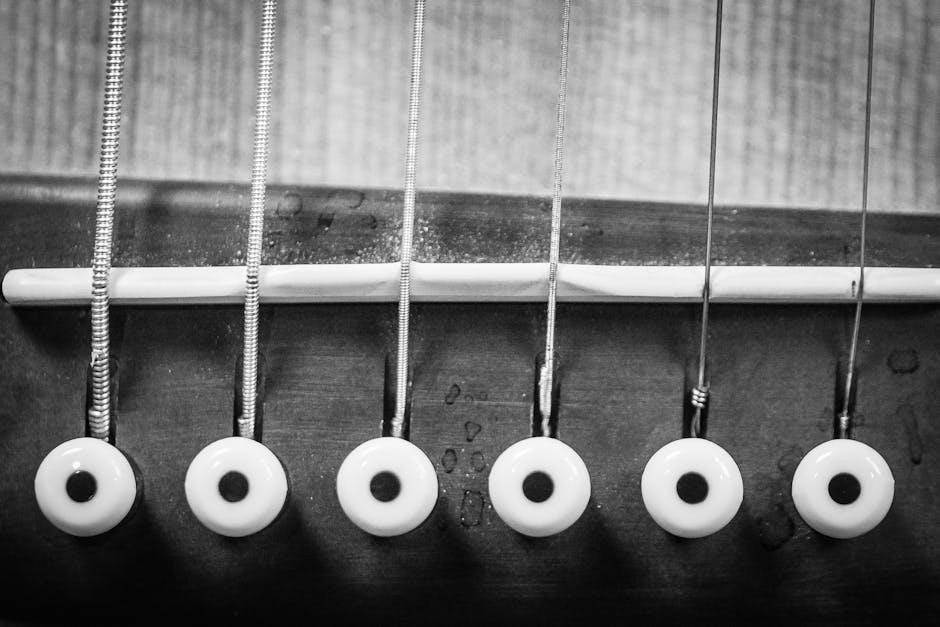Guitar chord diagrams are visual tools that simplify learning and playing chords. They display the guitar neck with dots indicating finger placements, lines for presses, and X’s for muted strings. These diagrams are essential for guitarists, providing clear guidance for finger positioning and string selection. A guitar chord diagram PDF offers a portable, offline resource for mastering chords, making it indispensable for practice and performance. Whether you’re a beginner or an advanced player, chord diagrams streamline the learning process, ensuring accuracy and efficiency in your musical journey.
What is a Guitar Chord Diagram?
A guitar chord diagram is a visual representation of the guitar neck, showing the specific placement of fingers on the strings and frets to play a chord. These diagrams typically display the neck vertically, with horizontal lines representing frets and dots indicating where fingers should press the strings. Open strings are often marked with an “O,” while muted strings may be marked with an “X.” Chord diagrams are essential for guitarists, as they provide a clear, concise way to learn and memorize chord shapes. They are particularly useful for beginners, as they offer a straightforward guide to finger placement and string selection. A PDF version of these diagrams is highly portable, allowing musicians to practice anywhere, even without internet access. This format ensures high-quality visuals and easy printing, making it a valuable resource for musicians of all skill levels.
Why Use a Guitar Chord Diagram PDF?
A guitar chord diagram PDF is an invaluable tool for musicians, offering portability and offline access to chord charts. PDFs provide high-quality visuals, ensuring clarity in finger placement and string selection. They are easily customizable and printable, allowing guitarists to create personalized practice materials. Whether you’re a beginner or an advanced player, a PDF chord chart is a convenient resource for mastering chords. It eliminates the need for internet access, making it ideal for practice sessions anywhere. Additionally, PDFs can be annotated, enabling users to mark favorite chords or note progress. With both free and paid options available, guitarists can choose the PDF that best suits their learning style and musical goals, making it an essential asset for any guitarist’s toolkit.

Types of Guitar Chords
Guitar chords include Major, Minor, Seventh, Power, and Barre chords, each offering unique sounds and techniques. A chord diagram PDF organizes these chords visually, aiding in learning and practice.
Major Chords
Major chords are foundational in music, providing a bright, harmonious sound. They consist of a root note, a major third, and a perfect fifth. For instance, a C Major chord includes notes C, E, and G. Guitar chord diagram PDFs simplify learning these chords by visually mapping finger placements on the fretboard. Beginners often start with open chords like C, G, D, and E, which are easily playable without a capo. Diagrams highlight the strings to play and fingers to use, ensuring clarity. With practice, these chords become the building blocks for more complex progressions, making them essential for every guitarist’s repertoire.
Minor Chords

Minor chords evoke a melancholic, introspective sound, making them a cornerstone of emotional expression in music. A minor chord consists of a root note, a minor third, and a perfect fifth. For example, an A minor chord includes notes A, C, and E. Guitar chord diagram PDFs provide clear visuals for these chords, marking finger positions and muted strings with X’s. Open minor chords like Am, Em, and Cm are often the first minors guitarists learn. These diagrams also help in identifying barre chords, which use movable shapes across the fretboard. By mastering minor chords, players can explore deeper musical emotions and expand their harmonic palette, making them indispensable for any guitarist’s skill set.
Seventh Chords
Seventh chords add depth and complexity to music by incorporating an additional note, the seventh, to the basic triad. They are categorized into types like major seventh, minor seventh, and dominant seventh, each offering distinct harmonic flavors. Major seventh chords, such as Cmaj7, create a bright, rich sound often used in jazz. Minor seventh chords, like Am7, convey a somber, introspective mood, while dominant seventh chords, such as C7, are versatile and commonly used in blues and rock for their tense, unresolved feel. Guitar chord diagram PDFs provide clear visual guidance for these chords, marking finger positions and string muting. They simplify the learning process, allowing guitarists to master these intricate harmonies and expand their musical expression.
Power Chords
Power chords are simplified versions of major or minor chords, consisting of only the root and the perfect fifth. They are versatile and widely used in rock, punk, and metal music for their bold, gritty sound. Power chords are played on the lower strings and are easy to shape, making them ideal for rhythm playing. They are also movable, allowing guitarists to play chords across different keys without changing the fingering pattern. Guitar chord diagram PDFs often include power chords, providing clear visuals for finger placement and string selection. These diagrams are invaluable for learning power chords quickly and effectively, especially for beginners looking to master the fundamentals of rhythm guitar playing.
Barre Chords
Barre chords are versatile and powerful, involving pressing multiple strings with one finger to create a movable chord shape. They are essential for playing chords in various keys and are widely used in many musical genres. Barre chords can be challenging due to the need for finger strength and proper technique to press the strings cleanly. A guitar chord diagram PDF provides clear visuals for mastering barre chords, showing the exact placement of the barre and additional fingers. These diagrams highlight the root note and intervals, making it easier to understand and memorize the shapes. With practice, barre chords open up a world of musical possibilities, allowing guitarists to play complex harmonies and progressions with precision and confidence.

How to Read a Guitar Chord Diagram
Start by identifying the vertical lines as frets and horizontal lines as strings. Dots indicate finger placements, with numbers showing which finger to use. An “X” means mute the string, while an “O” means play it open. The top line is the high E string, and the bottom line is the low E string. The chord name at the top helps identify the chord. A guitar chord diagram PDF provides clear visuals for each chord, making it easier to learn and play accurately. Practice matching the diagram to your guitar to master chord shapes and finger placements effectively.
Understanding the Guitar Neck Layout
The guitar neck layout is essential for interpreting chord diagrams. The neck is represented vertically, with frets as horizontal lines. The top of the diagram corresponds to the guitar’s headstock, while the bottom aligns with the body. Each vertical line represents a string, numbered from 1 (high E) to 6 (low E). Fret numbers are marked at the bottom, indicating where fingers press the strings. Open strings are shown as “0” or without a number. Muted strings are often marked with an “X,” while “O” indicates an open string played without pressing. The layout mirrors the actual guitar, making it intuitive to translate finger placements to the instrument. This visualization helps guitarist align their hands correctly, ensuring accurate chord shapes and clear tones. Mastery of the neck layout is foundational for effective use of chord diagrams.

Finger Positions and Numbers
Finger positions are crucial for playing chords accurately. On chord diagrams, numbers inside circles indicate which finger to use. Typically, 1 represents the index finger, 2 the middle, 3 the ring, and 4 the pinky. The thumb is rarely shown but may press the low E string in some chords. Proper finger placement ensures clean, clear tones. Diagrams often highlight optimal finger positions to avoid string muting or buzzing. By following these guides, guitarists can develop proper hand positioning and dexterity. Consistent practice with these numbered finger placements helps build muscle memory, making chord transitions smoother. Mastering finger positions is key to progressing as a guitarist and enhances overall performance quality. This system standardizes learning, making chord diagrams a reliable tool for players of all levels.

Note Names and Intervals
Note names and intervals are fundamental to understanding guitar chords. A chord is built from a root note and a series of intervals stacked above it. The root note defines the chord’s name, while the intervals determine its quality (major, minor, etc.). On chord diagrams, note names are often labeled above the strings or next to fret numbers, helping players identify the pitches being played. Intervals, such as thirds, fifths, and sevenths, are represented by the vertical arrangement of notes on the diagram. Recognizing these note names and intervals allows guitarists to grasp chord structures and relationships, enhancing their ability to play and create music effectively. This knowledge also aids in memorizing chords and understanding scales, making it a cornerstone of guitar musicianship.
String Numbers and Symbols
String numbers and symbols are essential components of guitar chord diagrams, providing clear guidance for players. The strings are typically numbered from 1 (thinnest, high E) to 6 (thickest, low E). Symbols like “X” indicate muted or unplayed strings, while “O” marks open strings. Numbers on the diagram represent which fret to press. These symbols ensure clarity, helping guitarists quickly identify which strings to play and how. Understanding string numbers and symbols is crucial for accurate chord execution. They simplify the learning process, making chord diagrams a powerful tool for musicians of all skill levels. This visual system allows guitarists to focus on technique and sound quality, enhancing their overall performance and musical expression.

Benefits of Using a PDF Chord Chart
A PDF chord chart offers high-quality visuals, ensuring clear finger placements and string details. It provides consistency across devices, making it ideal for practice and performance. This format enhances learning by maintaining uniformity and accessibility, helping guitarists master chords efficiently.
Portability and Offline Access
A guitar chord diagram PDF is lightweight and portable, allowing musicians to carry hundreds of chords anywhere. It eliminates the need for internet access, making it ideal for practice sessions, gigs, or travel. With a PDF, you can access chord charts on any device, ensuring uninterrupted learning and performance. This convenience is especially valuable for guitarists who need quick reference materials. The ability to print or view chord diagrams offline enhances versatility, making PDFs a go-to resource for both beginners and seasoned players. This portability ensures that musical progress isn’t hindered by location or connectivity issues, fostering continuous improvement and creativity.
High-Quality Visuals
A guitar chord diagram PDF provides crisp, high-resolution visuals that make learning chords straightforward. Clear illustrations of the guitar neck, precise finger placements, and detailed string notations ensure accuracy. These visuals are optimized for both digital viewing and printing, maintaining clarity on any device or paper. The high-quality images reduce eye strain and enhance comprehension, especially for complex chords. This visual clarity is invaluable for guitarists at all skill levels, as it helps in mastering chord shapes and transitions effortlessly. The professional presentation of these diagrams also makes them ideal for teaching and sharing knowledge with others, ensuring a consistent and effective learning experience. High-quality visuals are a cornerstone of effective chord diagrams, making them indispensable for musicians.
Customization and Printing
A guitar chord diagram PDF offers the flexibility to customize and print chord charts tailored to your needs. You can select specific chords, arrange them in a preferred order, and even add notes or annotations. This feature is particularly useful for creating practice sheets or set lists. Printing options allow you to produce high-quality, readable charts that are ideal for use during rehearsals or performances.Customization ensures that you only focus on the chords relevant to your current learning or playing goals, making your practice sessions more efficient. Additionally, blank chord templates are available, enabling you to design and print your own diagrams from scratch. This level of personalization enhances the learning experience, making it more engaging and effective for guitarists of all levels.

Resources for Downloading Guitar Chord PDFs
Discover a wide range of free and paid guitar chord diagram PDFs online, offering comprehensive chord charts, blank templates, and customizable layouts. Popular websites provide high-quality downloads, catering to both beginners and advanced players. These resources often include essential chords, alternate tunings, and detailed finger positions, making them invaluable for practice and performance. Whether you’re seeking specific chord sets or tools to create your own diagrams, these PDFs are a convenient and accessible solution for mastering guitar chords.
Free vs. Paid Resources
When searching for guitar chord diagram PDFs, you’ll find both free and paid options. Free resources are ideal for beginners, offering basic chord charts and diagrams. Many websites provide downloadable PDFs with essential chords, such as major, minor, and seventh chords. These are great for learning the fundamentals without cost. Paid resources, however, often include premium features like high-quality visuals, customizable layouts, and advanced chord variations. They cater to serious learners or those needing detailed, professional-grade materials. Some paid PDFs also offer blank templates for creating custom chord diagrams. While free options suffice for basic needs, paid resources provide comprehensive tools for in-depth learning and customization, making them worth the investment for dedicated guitarists.
Recommended Websites for Chord Charts
Several websites offer high-quality guitar chord diagram PDFs for download. Guitar Tricks and TrueFire provide extensive libraries of chord charts, catering to both beginners and advanced players. Justin Guitar is another excellent resource, offering free, printable chord diagrams along with lessons. Additionally, websites like Songsterr and Ultimate-Guitar host vast collections of chord charts in various formats. For those seeking blank templates, resources like Guitar Chords 365 allow users to create and customize their own chord diagrams. These websites are trusted by guitarists worldwide and offer a mix of free and premium content to suit different learning needs and preferences. They are invaluable tools for mastering guitar chords effectively.
Blank Chord Templates for Creation
Blank chord templates are indispensable tools for guitarists who want to create or customize their own chord diagrams. These templates, often available as PDFs, provide a structured layout of the guitar neck, allowing users to fill in finger positions, notes, and strings. Websites like Guitar Chords 365 and TrueFire offer downloadable templates that cater to both beginners and advanced players. Musicians can use these templates to design chord charts for specific songs, teaching purposes, or personal practice. They also serve as a creative outlet for developing new chord shapes or alternate tunings. By utilizing blank chord templates, guitarists can organize their chord knowledge efficiently and tailor their practice materials to meet their unique musical goals and preferences, enhancing their overall learning experience;

Advanced Guitar Chord Topics
Explore advanced techniques like alternate tunings, complex chord progressions, and barre chords across multiple keys. These topics expand your musical versatility and enhance your chord mastery.
Alternate Tunings and Chord Shapes
Alternate tunings and chord shapes expand your musical possibilities. Tunings like DADGAD or open D create unique sounds, while chord shapes adapt to these tunings seamlessly. Using a guitar chord diagram PDF, you can explore how standard chords transform in alternate tunings. For example, a basic E chord shape becomes a rich, open string chord in DADGAD tuning. This versatility allows for deeper musical expression and exploration of various genres. The PDF format provides clear visuals, making it easier to learn and experiment with these advanced techniques. By mastering alternate tunings and chord shapes, you can unlock new sounds and enhance your songwriting and improvisation skills, taking your guitar playing to the next level.
Chord Progressions and Songwriting
Guitar chord diagrams are invaluable for crafting chord progressions and writing songs. They provide a visual roadmap for transitioning between chords, helping you identify patterns and relationships. A guitar chord diagram PDF allows you to explore common progressions, such as I-IV-V, and experiment with variations. By studying these diagrams, you can discover how chords function within keys and create emotionally resonant sequences. Additionally, the portability of PDFs makes them ideal for songwriting on the go, enabling you to jot down ideas and refine them anywhere; Whether you’re composing originals or covering songs, chord diagrams simplify the process, ensuring your progressions sound cohesive and dynamic. This resource is a songwriter’s toolkit, inspiring creativity and streamlining the musical workflow.
Barre Chords in Different Keys
Barre chords are versatile and can be played in various keys by sliding the same shape up and down the neck. A guitar chord diagram PDF helps visualize these movable shapes, making it easier to adapt chords to different keys. For example, a barre chord shape in G major can be transposed to C major by moving it up three frets. This principle applies to minor, seventh, and other chord types. The diagrams highlight key fretboard patterns, allowing players to identify chord tones and intervals in any key. By mastering barre chords, guitarists can transition smoothly between keys and expand their musical versatility. Using a PDF chart, you can practice these shapes systematically, ensuring accuracy and consistency across all keys.

Practice Tips for Mastering Chords
Consistent practice is key to mastering chords. Start with slow, deliberate movements and gradually increase speed. Use a guitar chord diagram PDF as a practice guide to ensure accuracy and proper finger placement. Regular drills and focused repetition will build muscle memory and improve dexterity. Set achievable daily goals and track progress to stay motivated. Incorporating chord diagrams into your routine helps reinforce visual learning and ensures a strong foundation for playing chords confidently.
Building Finger Strength and Dexterity
Building finger strength and dexterity is crucial for mastering guitar chords. Start with simple exercises like finger stretches and chromatic scales to improve flexibility. Use a guitar chord diagram PDF to identify finger placements for each chord, ensuring proper technique. Practice changing chords smoothly by focusing on finger independence and minimal movement. Incorporate fingerpicking patterns and arpeggios to enhance dexterity. Regular practice, even for short durations, strengthens finger muscles and improves coordination. Over time, these exercises will make playing chords more effortless and precise, allowing you to focus on musical expression and overall performance quality.
Using Chord Diagrams for Memorization
Chord diagrams are invaluable for memorizing guitar chords effectively. By visualizing the neck and finger placements, players can commit shapes to memory. A guitar chord diagram PDF provides clear, concise visuals, making it easier to associate chords with their shapes rather than just finger positions. Start by focusing on basic chords, using diagrams to identify patterns and intervals. Over time, this visual association enhances muscle memory, allowing seamless transitions between chords. For advanced learning, explore diagrams for barre chords and seventh chords, which often share similar shapes across the fretboard. Consistent practice with these tools accelerates memorization, enabling players to perform confidently without relying on visual aids.
Common Chord Exercises and Drills
Mastering guitar chords requires consistent practice through targeted exercises and drills. Start with finger independence exercises to build dexterity, such as finger stretches and chromatic scales. Practice changing chords quickly between common progressions like C-G-Am-F to improve transitions. Use a metronome to enhance timing and precision. Another effective drill is playing chords in different keys or using movable shapes like barre chords. For beginners, focus on open chords, gradually incorporating seventh and minor variations. Advanced players can explore complex chord voicings and alternate tunings. Regular practice with a guitar chord diagram PDF ensures familiarity with shapes and finger placements, making these exercises more efficient and enjoyable. Consistency is key to mastering chord techniques and expanding your musical repertoire.
Mastering guitar chord diagrams with a PDF is transformative. It offers portability, offline access, and a clear path to chord mastery. Keep practicing and enjoy your musical journey!
Final Thoughts on Guitar Chord Diagrams
Guitar chord diagrams are indispensable tools for players of all levels. They provide clear, visual guidance for mastering chords, ensuring accuracy and efficiency. A guitar chord diagram PDF is a portable, versatile resource that enhances practice and performance. By using these diagrams, you can quickly identify finger positions, note names, and intervals, enabling you to play chords confidently. Whether you’re practicing at home or performing on stage, a PDF chord chart is an essential companion. It simplifies the learning process, helping you to focus on technique and musical expression. With consistent practice and the right resources, you’ll master the guitar and unlock endless creative possibilities.
Encouragement for Continuous Learning
Embrace the journey of guitar mastery with enthusiasm and dedication. Guitar chord diagrams are powerful tools to accelerate your progress, offering clarity and structure. A guitar chord diagram PDF provides a convenient way to practice anywhere, anytime. Don’t hesitate to explore free and paid resources, as they often include essential chords, blank templates, and advanced techniques. Consistent practice, even for short sessions, will build finger strength and dexterity. Use chord diagrams to memorize shapes and progressions, which are crucial for songwriting and improvisation. Stay motivated by setting achievable goals and celebrating small victories. The guitar is a versatile instrument, and with persistence, you’ll unlock its full potential, enjoying the rewards of creating beautiful music.